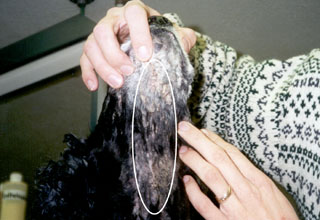
| This dog has a skin condition on the underside of the chin and neck called cutaneous lymphoma. |
Introduction: Detecting some sort of bump or mass on an animal is one of the most troublesome situations encountered by a pet owner. Questions arise concerning what type of mass it might be: Could the mass be cancerous? Are there other masses? What should I do? Peace of mind and answers to these questions can be found through the help of a veterinarian.

|
|
Some important facts that should be realized include the following:
The following information can be very helpful when discussing a mass with a veterinarian:
Diagnosis:
After a detailed history has been taken and a physical exam has been performed, some of the following procedures and tests may be required.
- In a procedure called a fine needle aspirate, a needle is inserted into the mass and a small sample is removed. Material collected from the needle is then stained and observed under magnification. The staining/magnification process is known as cytology. Cytology is useful in detecting the presence of infection, many types of inflammation, and may also be helpful in diagnosing certain types of cancer.
- A second method of taking a sample is called a biopsy. A biopsy involves taking a small sample of the mass using a variety of tools and techniques. Sometimes a mass can be completely re- moved as part of the biopsy procedure. Once a biopsy is taken, the sample is sent to a diagnostic laboratory for microscopic evaluation. Here the tissue is observed microscopically in its natural structure and relationship with surrounding tissue. At this point, a specialist known as a pathologist can often determine the source and identify/ name the mass or lump. To ensure proper treatment and prognosis, it is essential to biopsy a potentially cancerous mass.
Treatment: Therapy for all lumps and masses depends entirely on the diagnosis. This is why diagnostic testing for lumps and masses is of critical importance. Treatment for many masses (some tumors, cysts, warts, scar tissue, and granulomas) requires surgical removal. This is often all that is required and a full recovery can be expected. Malignant tumors most commonly require surgery, chemotherapy and/or radiation. Abscesses should be drained and may require antibiotic treatment. In cases of lymph node enlargement, the cause should be identified and may be treated with antibiotics.
See page F770 for additional information on tumors and masses.